 Humans
Humans  Humans
Humans  Animals
Animals 10 Animals That Humiliated and Harmed Historical Leaders
 History
History 10 Most Influential Protests in Modern History
 Creepy
Creepy 10 More Representations of Death from Myth, Legend, and Folktale
 Technology
Technology 10 Scientific Breakthroughs of 2025 That’ll Change Everything
 Our World
Our World 10 Ways Icelandic Culture Makes Other Countries Look Boring
 Misconceptions
Misconceptions 10 Common Misconceptions About the Victorian Era
 Mysteries
Mysteries 10 Strange Unexplained Mysteries of 2025
 Miscellaneous
Miscellaneous 10 of History’s Most Bell-Ringing Finishing Moves
 History
History 10 Great Escapes That Ended Right Back in Captivity
 Humans
Humans 10 Everyday Human Behaviors That Are Actually Survival Instincts
 Animals
Animals 10 Animals That Humiliated and Harmed Historical Leaders
 History
History 10 Most Influential Protests in Modern History
Who's Behind Listverse?

Jamie Frater
Head Editor
Jamie founded Listverse due to an insatiable desire to share fascinating, obscure, and bizarre facts. He has been a guest speaker on numerous national radio and television stations and is a five time published author.
More About Us Creepy
Creepy 10 More Representations of Death from Myth, Legend, and Folktale
 Technology
Technology 10 Scientific Breakthroughs of 2025 That’ll Change Everything
 Our World
Our World 10 Ways Icelandic Culture Makes Other Countries Look Boring
 Misconceptions
Misconceptions 10 Common Misconceptions About the Victorian Era
 Mysteries
Mysteries 10 Strange Unexplained Mysteries of 2025
 Miscellaneous
Miscellaneous 10 of History’s Most Bell-Ringing Finishing Moves
 History
History 10 Great Escapes That Ended Right Back in Captivity
10 Fun Stories About America’s Bootleggers
When the American government threw their lot in with the Temperance Movement and started the ill-fated experiment that was Prohibition, it started a weird period in America’s history where the criminal element gained something of a weird, favorable notoriety—especially the bootleggers, rumrunners, and moonshiners. The heroes of Prohibition, they kept a dry country from getting thirsty, and their methods make for some good stories.
10 Roy Olmstead
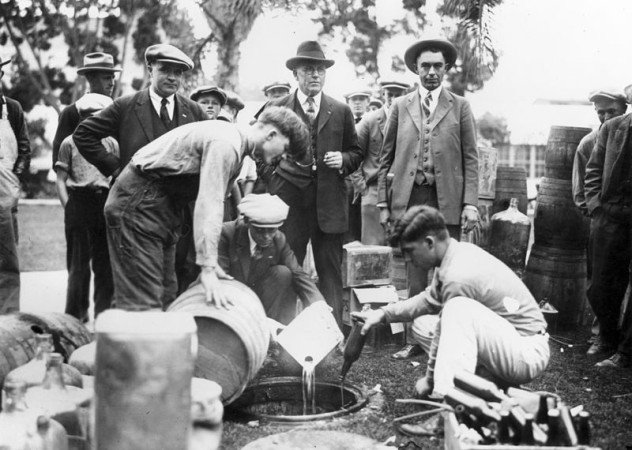
Roy Olmstead joined the Seattle police force nine years before Washington state went dry, so by the time he and his partners started busting bootleggers, he knew his way around the city. He also noticed something sad about all the busts they were making—they were sloppy, careless, and were missing so many obvious things that would make them much better at their chosen profession. It wasn’t long before he decided he could do much better and started running his own bootlegging business on the side. Alcohol was still legal in Canada, so Olmstead purchased Canadian liquor and shipped it south into the US.
Apparently, it was harder than it looked, because he was soon busted himself, fined $500, and kicked out of the police force. Not one to give up easily, he turned his business from a side job to full-time work, quickly building up the largest bootlegging empire in Seattle. He was one of the region’s largest employers, bringing in about $200,000 a month. After taking such a step up from his police department salary, Olmstead started rubbing elbows with the highest of the upper class, buying a mansion for himself and his wife. Her hobbies included reading children’s bedtime stories over her own radio station every night.
Their lavish lifestyle was short-lived, though, and their mansion was raided in 1924. The conviction was based largely on recordings that law enforcement had collected from illegal wiretapping. Olmstead, who knew about the wiretapping, also knew it was illegal, and was confident that whatever evidence they collected wouldn’t be used in court. However, the judge at his trial accepted the evidence—and so did the Supreme Court. Olmstead ended up serving four years, but was ultimately pardoned by Franklin Roosevelt.
9 Fort Whoop-Up
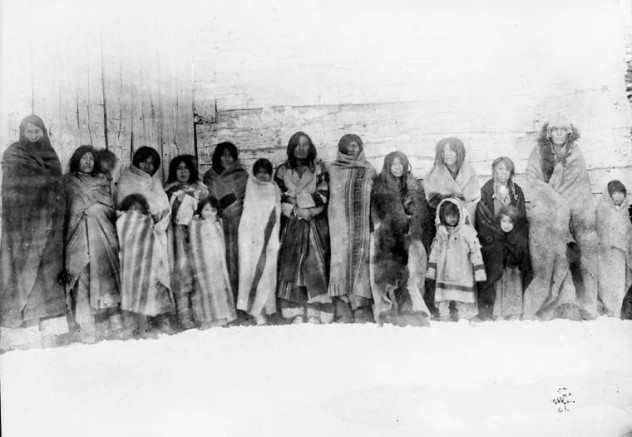
In the 1860s, the American West was still a land of rugged hunters, trappers, and gold prospectors. It was also highly illegal to trade their spoils for Canadian whiskey, so they headed up to the source of the whiskey itself—Alberta—and established the trading post with what might be the most epic name for a trading post ever. Fort Whoop-Up became known as the place to trade skins and hides for whiskey, and it made a lot of people very wealthy.
The problems started when the fort became incredibly popular, and eventually its expansion led to a dangerous melting pot. In addition to furs and alcohol, there were many firearms and the nearby Native American tribes had a tendency to clash with the white traders. When American traders brought smallpox with them, the disease started running through the Cree and Blackfoot tribes. Knowing that the other was vulnerable, this escalated conflict, making the Canadian government take notice of the trading loophole at Fort Whoop-Up. Ultimately, a group of 300 Canadian Mounties was sent to put an end to the trading and discreetly establish a firm Canadian military presence to discourage the traders from moving on and setting up elsewhere.
8 Pharmaceutical Chains
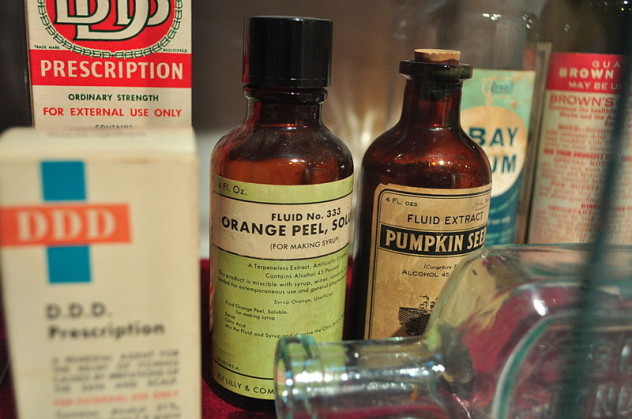
The years of Prohibition saw the opening of countless drugstores and pharmacy chains across the country. The reason was quite straightforward—they had suddenly become a very lucrative business. Not all alcohol had suddenly become illegal. It was still acceptable to distill and bottle whiskey, but only for medicinal purposes. These bottles were required to have a prescription—presumably issued by a doctor—fixed to the back, be stamped “Bottled-In-Bond,” and contain whiskey that was 100 proof.
Prescriptions could be refilled every 10 days, and the legality of selling whiskey through a pharmacy made it the perfect business front for bootleggers. There’s even a nod to the idea in F. Scott Fitzgerald’s The Great Gatsby where Gatsby made his living off a chain of drugstores, which was a blatant reference to his bootlegging operation.
Oddly enough, by this time the American Medical Association had already gone on record as saying that alcohol was not a recommended medicine for anything. However, the legislature enacting Prohibition ignored this minor detail, which meant a huge number of whiskey bottles were sold with labels that touted their contents were “Unexcelled for Medicinal Purposes.” Most prescriptions, given to the few people that even bothered with them, said that the bottles were for use in an “Emergency.”
Some of the drug store chains that saw unprecedented growth through Prohibition are still around today—the number of Walgreens stores in the country skyrocketed throughout the Prohibition years, although the official story is that it was due to the popularity of their recently introduced milkshakes.
7 Jennie Justo
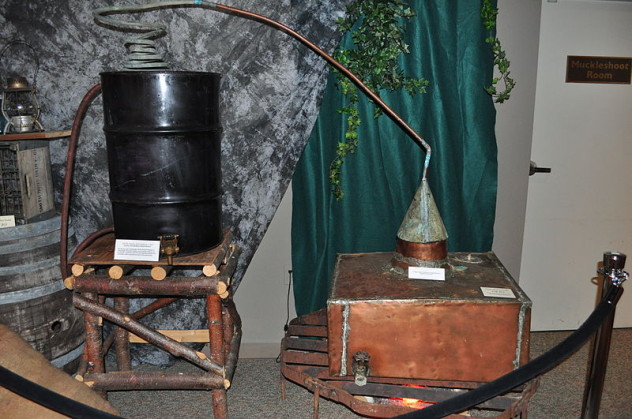
Jennie Justo was one of a handful of women who earned the title of “Queen of the Bootleggers,” but in Justo’s case, it certainly didn’t define who she was after Prohibition ended. Her real name was Vinzenza DiGilormo, and she was following her family’s tradition of living life on the wrong side of the law. Her father was killed in what was supposedly payback for her brother ratting out his bank heist accomplices. Afterward, it fell on Jennie to support her younger siblings, since her mother and other brothers also had run-ins with law enforcement.
Unlike many bootleggers, Jennie was known around town for her upstanding speakeasies and clientele. It was not surprising that she would want to keep things clean, as she was running her speakeasy out of her home. However, it wasn’t long before she was targeted by law enforcement. Rumor had it that she turned down a federal agent’s offer of a date, and after that, she wasn’t allowed to practice in any sort of peace.
She was ultimately arrested, spending six months in jail. Upon her release, she was greeted by loyal customers with flowers and something of a parade right back to the speakeasy. She was arrested again shortly thereafter, but her landlord took the fall for her. This was all for nothing, though, as she was still jailed on a probation violation. She was released after Prohibition was repealed, and she ultimately married Chicago Bears quarterback Arthur Bramhall. Together, they opened a completely legal new bar.
6 Rum Row
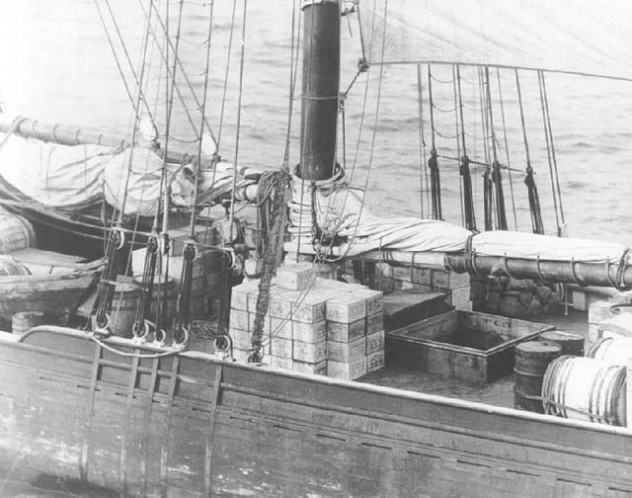
With liquor illegal on US territory, the next logical step was to take the party elsewhere. For bootleggers who looked to the seas to move their liquor, that meant Rum Row. Legally, the US government had no control over the seas about 5 kilometers (3 mi) out, so rumrunners and bootleggers would simply park their ships just off the East Coast and let word-of-mouth do the rest. Ships were bringing rum in from the Caribbean and liquor from Europe, and as long as they stayed beyond the 3-mile mark, no one could do anything about it.
Law enforcement didn’t like rumrunners giving them the completely legal middle finger, though, so they renegotiated the distance in 1924. After that, they would have control over the waters outside the country’s land for 19 kilometers (12 mi), making it much more difficult for bootleggers to hold their parties.
The ships of Rum Row had to be well-stocked for patrons, and that meant they were also prime targets. Those that owned and ran the boats were notoriously well-armed, but that didn’t deter many pirates. There are few recorded accounts, but there is one record of a French ship plundered for $800,000 worth of liquor over the course of 10 days. Other ships were simply found stripped and floating, without a crew.
A particularly resourceful group of pirates disguised their ship as a Coast Guard vessel, and boarded rumrunners dressed as US military. The ships of rumrunners were also very vulnerable, as the strip of sea where most set up camp was plagued by dense fog and unpredictable waves, leading to many crashing on the shores of New York and New Jersey.
5 America’s Small-Time Female Bootleggers

Selling illegal alcohol and making a mint wasn’t just a man’s game. There were a large number of female bootleggers that worked different areas of the country, particularly in the west. There, homes were further apart and everything was more remote, making it much more difficult for anyone to keep track of who was running a still in their yard or kitchen. Most of these women supplied local bars and speakeasies, doing quite well for themselves.
One Missouri-born woman named “Birdie” Brown moved to Montana, settling on a 25-acre homestead with a large log home, fields of crops, animals, and a fence around her entire property—a setup that cost quite a bit of money. She did, of course, fund her lifestyle with her home brew, touted throughout the area as the best in the country. Her story did not have a happy ending, though, as she was killed when her still exploded.
Even though most were operating on a much smaller scale than the likes of Al Capone, they were certainly no less creative. Mary Ann Moriarty ran a laundry business and tasked her daughter with delivering her clients’ clean clothes—along with flasks tucked into their laundry, charging $2 per gallon. Former dance hall girl Josephine Doody secured railroad men as her clients, and when the train pulled into town, they would blow the horn once for every gallon they wanted.
Women also had the benefit of being regulated by relatively lenient male law enforcement and judges, who were softer on them than on male bootleggers. Gray-haired mother Kate Farlan and 80-year-old Lavinia Gilman were given every consideration due to their gender and age—even considering that Gilman had been busted running a 300-gallon still.
4 The Bondurant Boys

As luck would have it, Jack Bondurant’s grandson would grow up to be a writer and immortalize his grandfather in a novel that became the feature film Lawless. As with any feature film, liberties were taken, but there wasn’t a need for that with the epic story of the three Virginia brothers. Family memories of a gruff, quiet farmer who raised beef cattle in Virginia turned into something more when Jack’s son decided he would try his hand at a little bit of genealogy. His research uncovered newspaper clippings and court records that painted a very different picture of the brothers.
In 1930s Virginia, moonshine ran like water—and a lot of it was transported in the back of a Bondurant truck. Violence went hand in hand with their moonshine operation, and Jack’s son remembers snapshots of small details like rusty brass knuckles discreetly hanging in the house, and the clink of glass bottles as they drove. Because Jack Bondurant died before his son and grandson had the chance to ask him more about his bootlegging days, most of what is known about them exists only in snapshots. They know there was an infamous law enforcement shootout at Maggodee Creek, with a corrupt cop running a protection scheme on the area’s bootleggers. One of the few mentions Jack made of his past was a nonchalant reveal of an old gunshot wound he’d received in the shootout.
Old family folklore also names the middle brother, Forrest, as something of a lucky charm—according to the story, he survived having his throat cut, walking through the snowy Appalachian Mountains for help. Grandson Matt Bondurant attributes his grandfather’s closed attitude about his past not to any sort of shame or embarrassment about his criminal activity, but to something much more pragmatic. Talking about what you did was just not done, as talking about it would get you—and your partners—killed.
3 Maggie Bailey
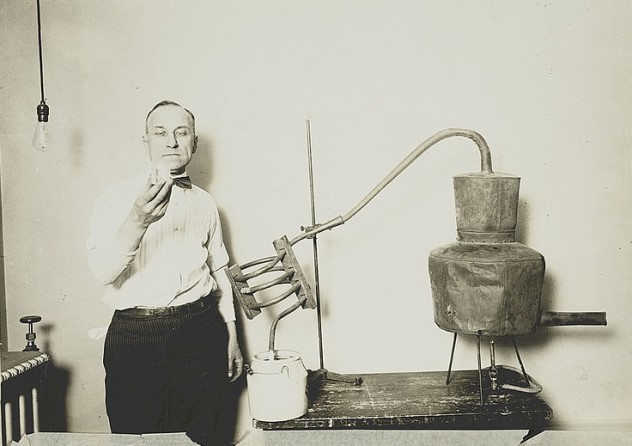
Maggie Bailey started making and selling her own moonshine during Prohibition. She kept on doing it well after Prohibition was repealed, and she loved it so much that she kept it up for almost 90 years. She was regularly harassed by law enforcement before and after Prohibition, since the white moonshine she was selling wasn’t legal, even after Prohibition. State and federal agents found it difficult to get any charges to stick on the Kentucky woman, who would attend court clad in a flower-printed apron, with her gray hair and a grandmotherly air.
The lack of guilty verdicts was likely due to her status in the community—she was loved by the people she sold her ‘shine to, and not just because she was their source for a drink. When people were struggling through the Depression, she would give them gallons of liquor on credit, allowing them to sell the liquor themselves, pay her back, and make a little money for themselves. She knew everyone in town, and she knew when they were having a tough time of it—she was well-known for bringing food to hungry families and even financing children’s education. She also made a point not to sell to children or to people that she knew had problems with alcohol abuse.
In her nearly nine decades of bootlegging, she served about 18 months of jail time for the only conviction that ever stuck. She died in 2005 at the age of 101. She was fond of saying that the excitement of her chosen pastime was what kept her young.
2 Daisy Simpson
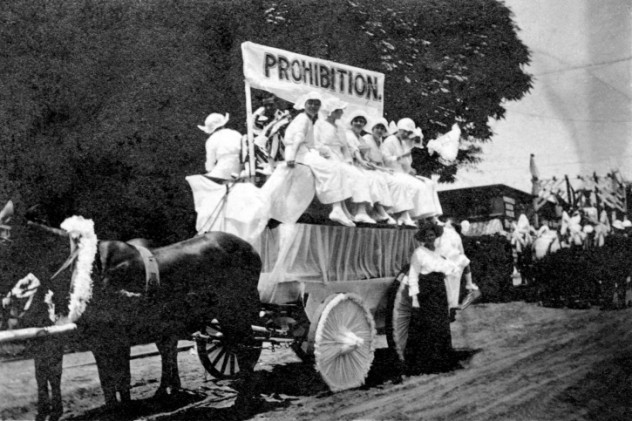
There would be no need for bootleggers to take precautions of any kind without law enforcement agents like the tenacious Daisy Simpson. One of the few female Prohibition agents, Simpson worked the streets of San Francisco—streets she had previously prowled on the other side of the law. A recovered drug addict, Simpson joined the Prohibition squad and took her job very seriously. Known to have 100 different disguises, she led raids that broke up speakeasies, bars, restaurants, and private parties. In order to get the evidence she needed, she’d often dress up in one of her many disguises and spend a few nights in her targeted establishment, arresting those who served her alcohol.
Simpson had a tendency to get a bit carried away, though, and was reprimanded by judges on several occasions for going too far with her arrests. While she was responsible for the seizure of 8,000 gallons of wine at a single winery, she also appeared in court to testify against a bellboy who brought her medicinal whiskey after she’d complained about stomach pains, as well as a man who had a single jug in his car that smelled like moonshine.
Eventually, she was bedridden from illness, relapsed into her old drug habit, and was arrested in Texas. Despondent over her failed marriage and her fall from grace, she smuggled a gun into jail and shot herself in the stomach. After a long, painful recovery, she paid her bail, moved back to California, and disappeared into anonymity.
1 Dutch Schultz And His Buried Treasure
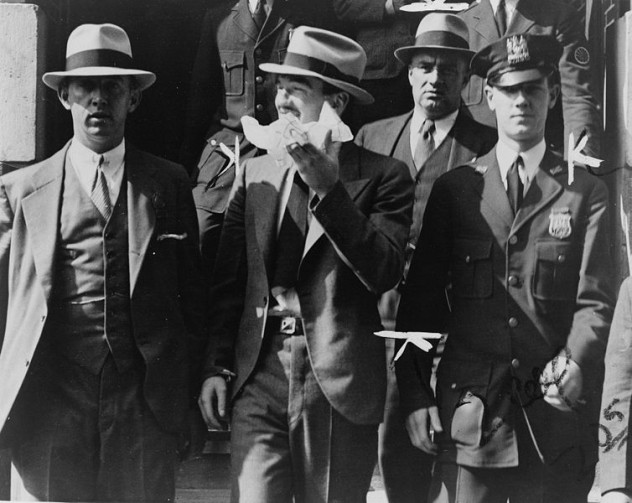
After a rough childhood and youth, Arthur Flegenheimer thought his name didn’t quite suit the man he was becoming, so he started going by the much tougher Dutch Schultz or “The Dutchman.” By the time he was in his early twenties, he had already joined up with a Bronx gang running liquor into the city (gang member leaving court pictured above), often stealing from other bootleggers and selling their newly acquired stock. He cut ties with the gang in the late 1920s and struck out on his own. Before long, all the beer that was distributed in the Bronx went through him.
His profits skyrocketed, helped by the slot machines he had installed in the places where people were drinking his alcohol. Much of his story is the typical mess of offended gangsters and failed hits, with the notable exception of the so-called Baby Massacre, a failed hit on him that instead ended with four children getting shot, with one dying from his wounds. After that incident, law enforcement looked at Schultz with a renewed interest, and like many Prohibition-era bootleggers and gangsters, they finally caught up with him.
Only Schultz wasn’t about to lose his fortune to law enforcement, the government, or the rest of his gang. According to legend, Dutch Schultz stashed his fortune, including cash and precious gems, in a tin trunk. He took it with him when he fled New York City through the Catskills. The story says that Schultz jumped off a train near Phoenicia and buried the trunk to keep it safe.
He was killed a short time later in a 1935 shooting, and the trunk has been pushed into the foggy area of folklore and wishful thinking. Some locals are convinced that the treasure—estimated to be worth about $83 million in today’s money—is still buried somewhere along the banks of a river. Others are equally convinced that the story is nothing more than a story. However, this hasn’t stopped people from looking, though nothing has been found—yet.








